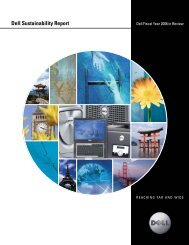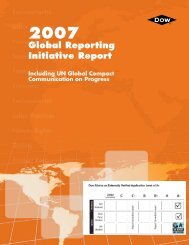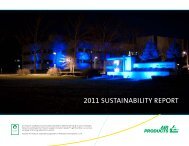Blueprint for Sustainability - Corporate - Ford Motor Company
Blueprint for Sustainability - Corporate - Ford Motor Company
Blueprint for Sustainability - Corporate - Ford Motor Company
- No tags were found...
You also want an ePaper? Increase the reach of your titles
YUMPU automatically turns print PDFs into web optimized ePapers that Google loves.
545DATA OVERVIEWData OverviewThis table provides three-year per<strong>for</strong>mance data accordingto a set of key indicators. Additional data are available in ourfull Web report.In previous sustainability reports, we organized our data andindicators around <strong>Ford</strong>’s Business Principles. This year –although most of the indicators themselves are the same asin years past – they have been organized into the broadercategories of Economy, Environment and Society. This shiftmirrors the organization of our Web report and representsan internal evolution in our approach to sustainability. It alsoaligns the report more clearly with the Global ReportingInitiative’s guidelines.This report covers the year 2007 and early 2008. The dataare primarily <strong>for</strong> 2007 (<strong>for</strong> operations) and <strong>for</strong> the 2007NOTES TO THE DATA1. GQRS customer satisfaction/TGWGQRS (Global Quality Research System) is a <strong>Ford</strong>-sponsored competitive research survey.GQRS is an early indicator of J.D. Power quality results. First-quarter 2008 GQRS customersatisfaction and TGW are 77 and 1,284 respectively. See Economy section in our Web report <strong>for</strong>a discussion of our ef<strong>for</strong>ts to improve quality.2. Sales satisfaction with dealer/retailer, <strong>Ford</strong> brand, U.S.Note that the measure changed in 2005 from “Percent Completely Satisfied” to “Net PromoterScore.” The data has been recalculated to reflect Net Promoter Scores.3. Service satisfaction with dealer/retailer, <strong>Ford</strong> brand, U.S.Note that the measure changed in 2005 from “Percent Completely Satisfied” to “Net PromoterScore.” The data has been recalculated to reflect Net Promoter Scores.4. Shareholder returnTotal shareholder return is from Bloomberg Total Return Analysis assuming dividendsreinvested in <strong>Ford</strong> stock.5. U.S. fuel economySee the Climate Change and Environment (Web report) sections <strong>for</strong> a discussion of our<strong>Corporate</strong> Average Fuel Economy (CAFE) per<strong>for</strong>mance. For the 2007 model year the CAFE ofour cars and trucks increased 5.9 percent. Preliminary data <strong>for</strong> the 2008 model year shows a 0.7percent improvement in CAFE compared to 2007, with a 1.3 percent improvement <strong>for</strong> cars anda 4.0 percent improvement <strong>for</strong> trucks. Improvement is reflected by increasing miles per gallon.The percentage improvement in CAFE <strong>for</strong> cars and trucks combined is lower than the respectivepercentages <strong>for</strong> both cars and trucks primarily because the ratio of trucks to cars manufacturedis projected to increase from 2007 to 2008. Also, the CAFE figure is calculated based on volumeof vehicles manufactured as well as the fuel economy of each individual vehicle.6. U.S. fleet CO2 emissionsSee the Climate Change section <strong>for</strong> a discussion of our CO2 emissions per<strong>for</strong>mance.Improvement is reflected by decreasing grams per mile.7. European CO2 per<strong>for</strong>manceOfficial EU data. Jaguar per<strong>for</strong>mance did not improve compared to 2005 and 2006 due tomodel mix.8. Worldwide facility energy and CO2 emissionsData have been adjusted to account <strong>for</strong> facilities that were closed, sold or new. This data doesnot include Automotive Component Holdings (ACH). This data has been adjusted to removeJaguar and Land Rover (JLR) in consideration of the pending sale of these brands.9. Energy and CO2 per vehicleEnergy consumption and CO2 emissions per vehicle divides energy used or CO2 emitted by thenumber of vehicles produced. Averaging energy and CO2 emissions by the number of vehiclesproduced yields a somewhat imperfect indicator of production efficiency. When the number ofvehicles produced declines, as it has since 2000, per-vehicle energy use tends to rise because aportion of the resources used by a facility is required <strong>for</strong> base facility operations, regardless ofthe number of vehicles produced.We believe that stable-to-declining per-vehicle energy use and CO2 emissions indicate thatmore-efficient production since 2000 is offsetting the tendency of these indicators to rise duringIn<strong>for</strong>mation Top 10factsLanguageglossaryQuestion Answer Do Don’t Exclamationiand 2008 model years (<strong>for</strong> vehicles). The data cover allof <strong>Ford</strong> <strong>Motor</strong> <strong>Company</strong>’s wholly and majority-ownedoperations globally, unless otherwise noted. Changes inXDirectionalsignpostCommunityaffairsQuote ContacttelephoneContact fax Contactemailthe basis <strong>for</strong> reporting or reclassifications of data previouslyreported are noted below and in the detailed data chartsof our Web report.ContactaddressInternalactivitiesWhere can I find these icons?If you would like any of these icons or <strong>for</strong> a newicon to be created please contact the Brand team,$CMIG brand enquiry.This report is aligned with the Global Reporting Initiative’sG3 <strong>Sustainability</strong> Reporting Guidelines, released in October2006, at a self-declared application level of “A”. A completeindex of GRI indicators is available in our Web report.More in<strong>for</strong>mation on the GRI and the applicationlevels can be found at www.globalreporting.orgperiods of declining production. This interpretation is rein<strong>for</strong>ced by our Energy Efficiency Index,which focuses on production energy efficiency, and which has been steadily improving. OurEnergy Efficiency Index target also has the effect of driving reductions in CO2 emissions.This data does not include our Automotive Components Holdings (ACH) facilities. Also, the datahas been adjusted to remove Jaguar and Land Rover (JLR) in consideration of the pending saleof these brands.10. North American Energy Efficiency IndexThe Index is “normalized” based on an engineering calculation that adjusts <strong>for</strong> typicalvariances in weather and vehicle production. The Index was set at 100 <strong>for</strong> the year 2000 tosimplify tracking against our target of one percent improvement in energy efficiency. Thisdata has been adjusted to remove Jaguar and Land Rover (JLR) in consideration of thepending sale of these brands.11. Employee satisfactionIn 2006, the Pulse survey was changed to incorporate new dimensions. While there was nochange to the number or content of the existing 55 core questions asked on Pulse, they wererealigned into eight revised dimensions. These changes were made because the reviseddimensions are: better focused on current business priorities, provide a framework <strong>for</strong> morefocused feedback and action planning, and two revised dimensions (including the revisedEmployee Satisfaction Index) can be benchmarked externally.12. Overall dealer attitudeThe National Automobile Dealers Association (NADA) Dealer Attitude Survey measures overalldealer attitude. Scores are <strong>for</strong> the summer and winter respectively of the year noted.13. <strong>Ford</strong> <strong>Motor</strong> <strong>Company</strong> Fund and corporate contributionsSee the Community section in our Web report <strong>for</strong> a description of our charitable contributions.14. Volunteer corpsThe Volunteer corps was founded in 2005, and 2006 is the first year data are available.However, volunteerism and community service have long been a part of <strong>Ford</strong>’s culture.15. RecallsRecalls are by calendar year rather than model year. A single recall may affect several vehiclelines and/or several model years. The same vehicle may have multiple recalls. (Source: U.S.National Highway Traffic Safety Administration.) Two 2007 recalls, affecting over 4.8 millionvehicles, are related to older technology components introduced in vehicles more than adecade ago.16. Top Safety PicksTo earn a Top Safety Pick from the Insurance Institute <strong>for</strong> Highway Safety (IIHS), a vehicle mustreceive a rating of “good” in offset frontal impact, side impact and rear impact evaluations,and offer electronic stability control. Top Safety Picks compare vehicles within the same sizecategories. Ratings across vehicle size categories should not be compared. IIHS first issuedTop Safety Picks in the 2006 model year.As we attempt to balance frequently changing government and non-government testrequirements with real-world safety, we have continued to assess the appropriate metrics <strong>for</strong>measuring our per<strong>for</strong>mance. We have chosen to present public domain safety ratings <strong>for</strong> all ofour models, rather than a percentage of models tested receiving a particular star rating, in ourfull Web report.In<strong>for</strong>mation Top 10factsLanguageglossaryQuestion Answer Do Don’t ExclamationiXDirectionalsignpostCommunityaffairsQuote ContacttelephoneContact fax ContactemailContactaddressInternalactivities

















